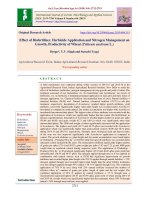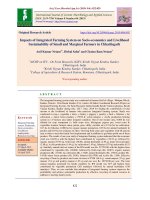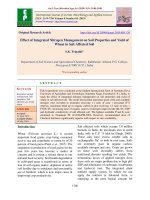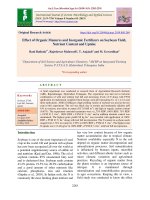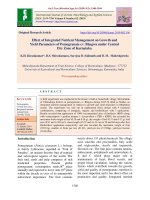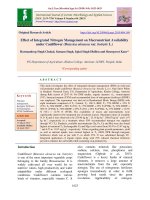Effect of integrated nitrogen management on macronutrient content and uptake of rice fallow Rabi blackgram
Bạn đang xem bản rút gọn của tài liệu. Xem và tải ngay bản đầy đủ của tài liệu tại đây (289.29 KB, 12 trang )
Int.J.Curr.Microbiol.App.Sci (2020) 9(7): 3458-3469
International Journal of Current Microbiology and Applied Sciences
ISSN: 2319-7706 Volume 9 Number 7 (2020)
Journal homepage:
Original Research Article
/>
Effect of Integrated Nitrogen Management on Macronutrient Content and
Uptake of Rice Fallow Rabi Blackgram
M. Latha*, P. Ratna Prasad, P.R.K. Prasad, R. Lakshmipathy and V. Srinivasarao
Department of Soil Science & Agril. Chemistry, Agricultural College, Bapatla, India
*Corresponding author
ABSTRACT
Keywords
INM, Yield of
blackgram, Nutrient
content, Nutrient,
Uptake by rice
fallow rabi
blackgram
Article Info
Accepted:
22 June 2020
Available Online:
10 July 2020
A field experiment was conducted on the residual effect of integrated nitrogen
management on rice and rice fallow blackgram crop. The major nutrient content (N, P &
K) and uptake by blackgram crop was studied during rabi season. The experiment was
conducted at College Farm, Agicultural College, Bapatla during the kharif and rabi
seasons of two years 2015 and 2016. The treatments consists of M 1(100% RDN) and M2
includes 50% RDN + 25% N through FYM + 25% N through neem cake + recommended
dose of microbial consortium (Azospirillum + PSB @ 2.5kg ha -1). The main treatments
were imposed during kharif seasons of both the years and their residual effect was studied
during rabi season with blackgram rabi crop. During the immediate kharif, the experiment
was laid out in a split plot design without disturbing the soil for succeeding rabi crops with
the two treatments given to kharif rice as main plot treatments and each of these divided
into five sub-plots. Popular cultivars of rice (BPT 5204) and blackgram (PU 31) were used
for this study. The highest nitrogen content was obtained in seed of blackgram (3.12 %)
during 2015-16 and 3.25% during 2016-17 year. The highest nitrogen uptake was noticed
in seed 95.03 kg ha-1 during 2015-16 and 104.81 kg ha-1 of blackgram during 2016-17
year. The overall highest phosphorus content was obtained in seed of 1.34% during 201516 and 1.25% during 2016-17 year. The overall highest phosphorus uptake was noticed in
seed of 40.81 kg ha-1 during 2015-16 and 40.31 kg ha-1 in seed of blackgram during 201617 year while the highest potassium content was obtained at harvest stage of haulm of
0.52%, 0.60% during first and second years. The overall 20.78 kg ha -1 and 20.67 kg ha-1 of
potassium uptakes were noticed in haulms of blackgram crop observed during 2015-16 and
2016-17 years respectively.
Introduction
In recent years there has been adverse effect
of continuous and indiscriminate use of
inorganic fertilizers on deterioration of soil
structure, soil health and environment.
Intensive cultivation, mono cropping, use of
imbalanced fertilization accompanied by
restricted use of organic manures and biofertilizers have made the soils not only
deficient in the nutrients but also deteriorated
the soil health resulting in decline of crop
response to the recommended dose of
fertilizers. The high cost of fertilizers and
unstable crop production call for substituting
part of the inorganic fertilizers by locally
3458
Int.J.Curr.Microbiol.App.Sci (2020) 9(7): 3458-3469
available organic sources like farmyard
manure, neem cake in an integrated manner
for sustainable production and to maintain
soil health. Integrated nitrogen management
involving conjunctive use of organic,
inorganic and crop residues may improve the
soil productivity and system productivity
become sustainable. Boosting yield, reducing
production cost and improving soil health are
three interlinked components of the
sustainability triangle. Therefore, combined
use of chemical fertilizers, organic manures
and bio fertilizers is essential.
Hence, the present experiment is formulated
to find out the residual effect of integrated
nitrogen management on rice and rice fallow
rabi blackgram crop and influence on nutrient
contents of blackgram.
medium range of organic carbon (0.55 and
0.50%). Low nitrogen content (266 and 250
kg ha-1), available phosphorus was (59 and 53
kg ha-1) and available potassium (630 and 668
kg ha-1).The initial soil analysis data is
presented in table 1.The present investigation
was undertaken during 2015-16 and 2016-17
of consecutive years.
Materials and Methods
The recommended fertilizer doses were
applied as 120-40-40, 20-50-0 kg N, P2O5 and
K2O ha-1 to rice and blackgram crops. The
soil samples were analysed as per standard
procedures for soil physical and physicochemical properties. Soil texture by Piper,
1966, bulk density by Dastane, 1967, water
holding capacity by Sankaram, 1966, soil
reaction and EC by Jackson, 1973, CEC by
Bower et al., 1952 and organic carbon by
Walkley and Black, 1934.
The
data
obtained during kharif 2015-16 and 2016-17
were analysed statistically using two sample
t-test analysis of variance (Panse and
Sukhatme, 2000). The t-test value calculated
for 12 replications and t-test value was 2.07.
If the t-test value was >2.07, it was
significant, while <2.07 includes nonsignificant. Whereas the data obtained during
rabi 2015-16 and 2016-17 were analyzed
statistically by following split plot design as
suggested by Gomez and Gomez (1984).
Wherever, the treatment differences were
found significant, critical differences were
worked out at five per cent probability level
and furnished along with mean values of the
parameter concerned in tables. Nonsignificant treatmental differences were
A field experiment was conducted for two
consecutive years (2015-16 & 2016-17) on
clayloam soils of Agricultural College Farm,
Bapatla. The experiment was laid out in a two
sample t-test for rice in kharif season with 2
treatments and replicated thrice. The
treatments consists of M1 100% RDN, M2
(50% RDN + 25% N through FYM + 25% N
Through neem cake + Azopsirillum + PSB @
2.5 kg ha-1 (INM). During the immediate
kharif, the experiment was laid out in a split
plot design without disturbing the soil for
succeeding rabi crops with the two treatments
given to kharif rice as main plot treatments
and each of these divided into five sub-plots.
The experiment was repeated in another field
during kharif and rabi seasons. Popular
cultivars of rice (BPT 5204) and blackgram
(PU 31) were used for this study.
The soil was vertisol with bulk density (1.42
& 1.43), porosity (43.50 and 43.80%) and
water holding capacity (45.10 & 45.80%),
slightly alkaline in reaction, (pH 7.70 and
7.50), two fields were non-saline in nature,
cation exchange capacity (35.4 & 37.2),
The nutrients were applied through the
fertilizers like urea, single super phosphate,
muriate of potash. The farm yard manure and
neem cake was applied at seven days before
transplanting of rice on dry weight basis as
per the treatment. The bacterial inoculants
applied at the time of sowing as per
recommended dosage (Azospirillum + PSB @
5.0 kg ha-1).
3459
Int.J.Curr.Microbiol.App.Sci (2020) 9(7): 3458-3469
denoted by “NS”.
below.
Collection and processing of plant samples
Nutrient uptake (kg ha -1) =
Blackgram plant samples were collected from
five random sites in each treatment at
different growth stages and sent for laboratory
for further analysis. The samples were first
dried in shade and then in hot air oven at
65oC. The plant samples were ground in
willey mill and stored in labeled brown paper
bags for analysis. The grain samples were
also processed and stored in similar fashion.
Nutrient content (%) x dry matter in kg ha-1
Nitrogen
Nitrogen content in plant samples was
determined by micro Kjeldahl method (Piper,
1966).
Preparation of di-acid mixture
Di-acid extract was prepared as per the
method outlined by Jackson (1973). It was
carried out using a 9:4 mixture of HNO3:
HClO4. The pre-digestion of sample was done
by using 10ml of HNO3 g-1 sample. This diacid extract was used to determine P and K
contents in the plant and grain samples.
Phosphorus
It was determined spectrophotometrically by
vanadomolybdate phosphoric acid yellow
color method as described by Jackson (1973)
from di-acid extract.
Potassium
It was estimated from di-acid extract by using
flame photometer (Jackson, 1973).
Nutrient uptake
From the chemical analytical data, uptake of
the each nutrient was calculated as shown
100
Results and Discussion
Seed yield of Blackgram
Seed yields of blackgram were presented in
table 2 and depicted in figure 1. Significantly
highest seed yield was obtained in residual
effect of M2 treatment with values of 1118
and 1210 kg ha-1 in the year 2015-16 and
2016-17, respectively. These yields were
higher by 21.9% and 10.40% over M1 during
first and second years, respectively, which
indicated the residual effect of INM treatment
(M2) imposed in rice during kharif.
Similar
results
were
obtained
by
Gajendrasingh et al. (2016) who reported that
residual effect of INM had showed the highest
seed yield in blackgram compared to
inorganics alone. Shashikumar et al. (2013)
had also stated that highest yields were
obtained with organics in conjunction with
inorganics. Growth regulators combinedly
affect the grain yield of blackgram crop.
Geetha and Velayutham, (2016) also
supported that the fertilizer application
methods followed in the preceding rice crop
did exert significant variation in the grain
yield of succeeding blackgram crop and the
percent of yield increase due to fertilizer
application to blackgram was 12% over
application of the recommended dose of
fertilizer to preceding rice crop. The increase
in yield might be due to enhancement in
growth and yield parameters as well as uptake
of nutrients by crop. Obviously, the
cumulative effects of these parameters might
have contributed to increased grain yield
3460
Int.J.Curr.Microbiol.App.Sci (2020) 9(7): 3458-3469
potential of the crop. Anulavanya and
Ganapathy, (2010) stated that the maximum
seed yield was recorded with 2% DAP + biofertilizers. The rhizobium inoculation formed
good nodulation and increased blackgram
showing effective symbiosis which might
have left appreciable amount of N to increase
yield. Phosphobacteria application made the
insoluble phosphates present in the soil into
soluble forms by secreting organic acids
resulting in effective solubilization and
utilization of phosphorus.
Devaraju and Senthivel (2018) concluded that
the grain yield was increased with application
of pulse wonder @ 5kg/ha (organics) gave
significantly highest grain yield than other
treatments. The increase in yield might be due
to enhanced yield attributes like number of
pods plant-1, number of seed pod-1 and
increased uptake of nutrients by blackgram by
effective translocation of nutrients from sink
to reproductive area of crop. Selvakumar et
al. (2009) stated that the yield of blackgram
increased with biofertilizers (dual inoculation
of rhizobium with phosphobacteria). It was
evident that INM treatment increased plant
height, leaf number and leaf area contributing
to increased yield. Senthivalavan and
Ravichandran (2016) reported that residual
effect of integrated plant nutrient supply NPK
ha-1 along with 12.5 t ha-1 FYM and
biofertilizers viz., Azospirillum and PSB as
soil treatment obtained increased seed yields.
This might be due to better availability of P to
blackgram during rabi season when applied to
preceding rice crop in kharif season.
treatment was confirmed with the above
significant increase in haulm yield.
The application of organics along with 50%
RDN showed the increments in yield of
haulm yields. Similar type of results were
found with Gajendrasingh et al. (2016) and
the increase of yield in organic manure
treatment was
due to the higher
photosynthetic activity in blackgram plant
leading to the better supply of carbohydrates
resulting in more number of branches and dry
matter. Increase in straw yield might be due to
the cumulative influence of improvement in
vegetative growth of crop through the
atmospherically nitrogen fixed in the root
nodules Ghosh and Joseph (2008).
Senthivalavan and Ravichandran (2016)
reported that integrated plant nutrient supply
NPK along with FYM and biofertilizers viz.,
Azospirillum and PSB as soil treatment
obtained increased seed and haulm yields.
This might be due to better availability of
phosphorus to blackgram during rabi season
when applied to preceding rice crop in kharif
season. The superiority of residual effect of
FYM and biofertilizers through efficient
utilization of mineralized N and Zn from
FYM along with atmospheric N fixed by the
crop itself (by increasing the activity of
nodule bacteria would have increased the
availability of N throughout the growth period
and thereby increased the assimilation of
photosynthates which in turn better source
and sink relationship led to better
performance of rice fallow blackgram crop.
Haulm yield of blackgram
Harvest index
To evaluate the residual effect of INM
practice imposed in kharif rice, the rabi yields
of blackgram haulm yield were recorded in
table 2 and depicted in figure 1. The haulm
yields of INM (M2) treatment were higher by
91(6.33%) and113kg ha-1(7.52%) over M1
(only inorganics). The residual effect of INM
Significantly higher harvest index was
obtained with residual effect of INM
treatment in both the years. The conversion of
biomass into reproductive organs of yield
attributing character was revealed in INM
treatment. Harvest index value was recorded
in M1 (39.85%) over than that of M2 (42.25%)
3461
Int.J.Curr.Microbiol.App.Sci (2020) 9(7): 3458-3469
during 2015-16 year and 42.18 to 42.83%
during the year 2016-17.
Nutrient content and uptake
Nitrogen
The experimental results pertaining to
nitrogen content at different growth stages of
blackgram crop are presented in table 3. Data
indicated that there was significant residual
effect of M2 (INM) treatment over 100%
RDN on nitrogen content of blackgram. At all
the growth stages of blackgram the N content
was significantly higher with M2 treatment
than M1 during both the years of study.
The nitrogen content was gradually decreased
with the age of the crop i.e from vegetative
stage to flowering stage. The highest nitrogen
content was obtained within seed of 3.12 %
during 2015-16 and 3.25% during 2016-17
year. This was coincided with the results of
Gajendrasingh et al., (2016) and due to the
increased root development and more nutrient
availability, resulting in better absorption and
utilization of all plant nutrients, thus resulting
in more nitrogen content in seed. Rhizobium
inoculation increased the root nodulation
through better root development and more
nutrient availability, resulting in better
absorption and utilization of all plant
nutrients, thus resulting in more nitrogen
content in seed. Similar type of results was
reported by Singh and Pareek, (2003).
The experimental results pertaining to
nitrogen uptake at different growth stages of
crop are presented in table 4. Data indicated
that there was significant influence of the
residual effect of M2 treatment over 100%
RDN (M1). The significant increase was
noticed in nutrient uptake during two years of
study.
The nitrogen uptake was also increased from
vegetative stage to flowering stage. The
highest nitrogen uptake was noticed in seed
95.03 kg ha-1 during 2015-16 and 104.81 kg
ha-1 of blackgram during 2016-17 year.
Similar type of range of nitrogen uptakes by
blackgram crop was happened with
Gajendrasingh
et
al.
(2016)
and
Senthilvalavan and Ravichandran, (2016).
Phosphorus
The experimental results pertaining to
phosphorus content at different growth stages
of blackgram are presented in table 3. Data
indicated that there was significant influence
of the residual effect of M2 treatment over
100% RDN at all the growth stages in both
years of study. Mir et al. (2013) stated that
phosphorus solubilizers increased the
availability thereby improved phosphorus and
plant and uptake of nutrient manifested in
increased concentration.
The phosphorus content was gradually
decreased with the age of the crop i.e from
vegetative stage to flowering stage. The
overall highest phosphorus content was
obtained in seed of 1.34% during 2015-16 and
1.25% during 2016-17 year. This was
coincided with those of Gajendrasingh et al.
(2016).
The higher phosphorus content in seed was
due to increased better root development and
more nutrient availability, resulting in better
absorption and utilization of all plant
nutrients, thus resulting in more phosphorus
content in seed.
The experimental results pertaining to
phosphorus uptake at different growth stages
of crop are presented in table 4.
3462
Int.J.Curr.Microbiol.App.Sci (2020) 9(7): 3458-3469
Table.1 Initial properties of the experimental soil
Particulars
I. Physical properties
Mechanical composition
1. Sand (%)
2. Silt (%)
3. Clay (%)
Textural class
Bulk density (Mg m-3)
Porosity(%)
Water holding capacity (%)
II. Physico-chemical properties
pH (1:2.5)
EC (dS m-1)
Cation exchange capacity
(cmol (p+) kg-1)
Organic carbon (%)
III. Available nutrients
N (kg ha-1)
P2O5 (kg ha-1)
K2O (kg ha-1)
Particulars
IV. Secondary nutrients
Exchangeable Ca (cmol (p+) kg-1)
Exchangeable Mg (cmol (p+) kg-1)
SO4-2 - Sulphur (mg kg-1)
V. Available micro nutrients (mg kg-1)
Iron
Manganese
Zinc
Copper
VI. Biological properties
Dehydrogenase activity
(μg TPF g-1 24h-1)
Microbial populations
Bacteria count
(105 x cfu g-1 soil)
Fungi (103x cfu g-1 soil)
Actinomycetes
(103 x cfu g-1 soil)
2015-16
2016-17
42
20
38
Clay loam
1.44
43.50
45.10
40
21
39
Clay loam
1.43
43.80
45.80
7.70
7.50
0.26
35.4
0.31
37.2
Neutral to slightly
alkaline in nature
Non-saline
Normal
0.55
0.50
medium
266
59
630
2015-16
250
53
668
2016-17
Low
High
Very high
Class/ Group
23.39
5.80
15.00
24.07
5.70
15.50
Normal
Normal
Normal
27.50
5.50
2.55
0.59
25.00
4.90
2.65
0.65
Sufficient
Sufficient
Sufficient
Sufficient
49.14
39.15
Normal
20.0
25.0
Normal
10.0
15.0
8.0
15.0
Normal
Normal
3463
Class/ Group
Clay loam
Normal
Normal
Normal
Int.J.Curr.Microbiol.App.Sci (2020) 9(7): 3458-3469
Table.2 Effect of Integrated Nitrogen Management on yield attributes and yield of rice fallow rabi blackgram
Treatment
2015-16
2016-17
100 seed
weight(g)
Seed
yield
(kg ha-1)
Haulm
yield
(kg ha-1)
Harvest
Index
(%)
100 seed
weight(g)
Seed
yield
(kg ha-1)
Haulm
yield
(kg ha-1)
Harvest
Index
(%)
M1 : 100 % RDN
3.98
917
1437
38.95
4.55
1096
1502
42.18
M2 : 50% RDN+25% N - FYM+
25% N - neem cake +
bacterial consortium
4.17
1118
1528
42.25
4.91
1210
1615
42.83
t-value
9.76
14.10
5.15
2.15
8.11
4.75
12.85
2.07
3464
Int.J.Curr.Microbiol.App.Sci (2020) 9(7): 3458-3469
Table.3 Effect of Integrated Nitrogen Management on N, P and K contents in rice fallow rabi blackgram
Treatment
2015-16
2016-17
Vegetative
Flowering
Haulm
Seed
Vegetative
Flowering
Haulm
Seed
M1: 100 % RDN
1.56
1.36
0.44
3.05
1.58
1.48
0.54
3.11
M2: 50% RDN+25% N - FYM+ 25%
N - neem cake + bacterial
consortium
1.63
1.46
0.62
3.12
1.86
1.59
0.66
3.25
t - value
3.60
2.51
4.56
5.92
3.69
2.11
2.15
2.11
M1: 100 % RDN
0.33
0.30
0.28
1.08
0.45
0.40
0.32
0.99
M2: 50% RDN+25% N - FYM+ 25%
N - neem cake + bacterial
consortium
0.38
0.35
0.33
1.34
0.64
0.60
0.43
1.25
t - value
2.34
2.19
2.42
2.52
4.79
3.77
2.27
2.16
M1: 100 % RDN
1.24
1.18
1.04
0.41
1.36
1.26
1.02
0.55
M2: 50% RDN+25% N - FYM+ 25%
N - neem cake + bacterial
consortium
1.39
1.29
1.36
0.52
1.48
1.37
1.28
0.60
t - value
2.25
2.17
3.34
2.13
2.56
2.20
2.17
2.17
Nitrogen(%)
Phosphorus (%)
Potassium(%)
3465
Int.J.Curr.Microbiol.App.Sci (2020) 9(7): 3458-3469
Table.4 Effect of Integrated Nitrogen Management on macronutrient uptake by rice fallow rabi blackgram
Treatment
2015-16
2016-17
Vegetative
Flowering
Haulm
Seed
Vegetative
Flowering
Haulm
Seed
M1: 100 % RDN
1.43
11.68
6.32
27.9
1.40
12.81
8.11
34.85
M2: 50% RDN+25% N - FYM+
25% N - neem cake + bacterial
consortium
2.44
13.72
4.27
34.8
3.06
16.02
10.65
39.32
t - value
2.15
7.07
6.26
18.14
2.35
2.93
3.47
3.77
M1: 100 % RDN
0.30
2.57
4.02
9.90
0.40
3.46
4.80
10.85
M2: 50% RDN+25% N - FYM+
25% N - neem cake + bacterial
consortium
0.57
3.29
5.04
14.98
1.05
3.65
6.94
15.12
t - value
2.17
11.63
3.30
4.41
2.92
9.47
2.93
3.06
M1: 100 % RDN
1.14
10.13
14.9
3.75
1.21
12.64
15.32
4.82
M2: 50% RDN+25% N - FYM+
25% N - neem cake + bacterial
consortium
2.08
12.12
20.78
5.81
2.44
16.09
20.67
6.77
t - value
2.45
3.53
4.54
5.17
2.79
9.43
3.45
3.34
-1
Nitrogen (kg ha )
-1
Phosphorus (kg ha )
Potassium (kg ha-1)
3466
Int.J.Curr.Microbiol.App.Sci (2020) 9(7): 3458-3469
Fig.1 Effect of Integrated Nitrogen Management on yield of rice fallow rabi blackgram
The phosphorus uptake also increased from
vegetative stage to flowering stage. Data
indicated that there was significant increase of
the residual effect of M2 treatment over 100%
RDN had given the significantly higher
phosphorus uptake. The significant increase
was noticed in nutrient uptake during two
years of study. The overall highest
phosphorus uptake was noticed in seed of
40.81 kg ha-1 during 2015-16 and 40.31 kg
ha-1 in seed of blackgram during 2016-17
year. Similar type of range of phosphorus
uptake observed by blackgram crop was
noticed with Harishkumarmehta et al ( 2015).
Potassium
Potassium content at different growth stages
of crop were presented in table 3. Potassium
content was gradually decreased with the age
of the crop i.e from vegetative stage to
flowering stage. The highest potassium
content was obtained at harvest stage of
haulm of 0.52% during first and 0.60% during
second year (Mir et al., 2013).
There was significant residual effect of M2
treatment over 100% RDN. Irrespective of
growth stage the highest potassium content
was obtained with residual effect of M2 over
M1 (only inorganics). Similar type of results
was quoted by Harishkumarmehta et al.,
(2015). There was residual effect of M2
treatment over 100% RDN. Similar type of
potassium
uptakes
were
stated
by
Gajendrasingh et al. (2016).
The potassium uptake was also increased
from vegetative stage to flowering stage as it
is a product of content and dry matter. The
significant increase was noticed in nutrient
uptake during two years of study. The overall
highest nutrient potassium uptake was noticed
in haulm of 20.78 kg ha-1 during 2015-16 and
20.67 kg ha-1 in haulm of blackgram during
2016-17 year.
The highest nutrient uptakes of blackgram
were obtained due to higher dry matter
production and increased availability of
nutrients from the INM might have enhanced
the K uptake. These results were in
conformity with the findings of Geetha and
Velayutham (2016).
In conclusion, application of integrated
nitrogen
management
improved
the
macronutrient content and uptake of rice
fallow rabi blackgram with the implication of
3467
Int.J.Curr.Microbiol.App.Sci (2020) 9(7): 3458-3469
M2 {50% RDN + 25% N through FYM +
25% N through neem cake + recommended
dose of microbial consortium (Azospirillum +
PSB @ 2.5kg ha-1} during kharif season.
Nitrogen, Phosphorus and potassium uptakes
in seed were increased 24.7%, 51% and 69%
respectively during first year and in second
year 13.9%, 48%and 40% increments were
noticed in seed uptakes of N, P and K
respectively. This conclusion was based on
two years study the evaluation and assessment
need long-term experimentation on different
agro-climatic conditions and locations.
References
Anu Lavanya, G and Ganapathy, M. 2010.
Yield maximization of blackgram in
rice fallow blackgram through organic
sources of nutrient management
practices in Cauvery deltaic areas.
Legume Research, 33(4):291-294.
Bower, C.A., Reitemeier, R.F and Fireman,
M. 1952. Exchangeable cations analysis
of saline and alkali soils. Soil Science,
73: 251-261.
Dastane, N.G., 1967. A Practical Manual for
water use research, Navabharat,
Prakashan Publication, Poona (India),
120.
Devaraju, B and Senthivel, T. 2018. Effect of
foliar application of different sources of
nutrients on growth and yield of
blackgram under irrigated conditions.
International Journal of Current
Microbiology and applied Sciences.
7(10): 3105-3109.
Gajendra Singh, Pushkar Choudhary, Bharat
Lal Meena, Rajveer Singh Rawat and
Bhanwar lal Jat, 2016. Integrated
nutrient management in Blackgram
under rainfed condition. International
Journal of Recent Scientific Research,
7(10): 13875-13894.
Geetha, P and Velayutham, A. 2016. Yield
attributes, yield and uptake of nutrients
as influenced by basal and foliar
application of nutrients on rice fallow
blackgram,
Indian
Journal
of
Agricultural Research., 50(2): 122-125.
Ghosh, M. K and Joseph, S. A. 2008.
Influence of biofertilizers, foliar
application of DAP and sulphur sources
on yield and yield attributes of summer
greengram. Legume Research, 31(3):
232-233.
Gomez, K. A and Gomez, A.A. 1984.
Randomized Block Design in Statistical
Procedure for Agricultural Research.
Published by a Wiley Inter Science,
USA: 621-635.
Harish Kumar Mehta, R., Subhash Reddy, P.,
Jayamma and Naveen Kumar, R. 2015.
Influence
of
biofertilizers,
vermicompost and chemical fertilizers
on growth, nodulation, nutrient uptake,
seed yield and economics of blackgram.
International Journal of applied biology
and Pharmaceutical Technology. 6(3):
249-251.
Mir, A. H., Lal, S. B., Salmani, M., Abid, M
and Khan, I. 2013. Growth, yield and
nutrient content of blackgram as
influenced by levels of phosphorus,
sulphur and phosphorus solubilizing
bacteria. SAARC. Journal, 11(1):
1-6.
Panse, V. G and Sukhatme, P. V. 2000.
Statistical methods for Agricultural
workers. Published by ICAR, New
Delhi.
Piper, C. S. 1966. Soil and plant analysis.
Hans Publishers, Bombay: 368.
Sankaram, A. 1966. A laboratory manual for
agricultural chemistry. Asia publishing
House. Bombay. 41-149.
Selvakumar, G. Lenin, M., Thamizhiniyan, P
and Ravimycin. 2009. Response of
biofertilizers on the growth and yield of
blackgram. Recent research in science
and Technology,1(4): 169-175.
Senthilvalavan, P and Ravichandran, M.
3468
Int.J.Curr.Microbiol.App.Sci (2020) 9(7): 3458-3469
2016. Residual effect of nutrient
management practices on the yield,
NPK uptake and profitability of rice
fallow blackgram. Asian Journal of
Science and Technology, 7(1): 23052310.
Shashikumar, Basavarajappa, Salikinkkop, S.
R., Majunatha Hebbar, Basavarajappa,
M. P and Patil, H. Y. 2013. Effect of
growth regulator, organic and inorganic
foliar nutrition on the growth and yield
of blackgram under rainfed condition.
Karnataka Journal of Agricultural
Sciences, 26(2): 311-313.
Singh , B and Pareek R G, 2003. Studies on
phosphorus and nbio-inoculants on
biological
nitrogen
fixation,
concentration, uptake, quality and
productivity of mung bean. Annals of
Agriculture New Series. 24(3): 537541.
Walkley, A. Black, A. 1934. An Examination
of degtjareff, method for determining
soil organic matter and a proposed
modification of the chromic acid
titration method. Soil Science. 37: 2938.
How to cite this article:
Latha, M., P. Ratna Prasad, P.R.K. Prasad, R. Lakshmipathy and Srinivasarao, V. 2020. Effect
of Integrated Nitrogen Management on Macronutrient Content and Uptake of Rice Fallow Rabi
Blackgram. Int.J.Curr.Microbiol.App.Sci. 9(07): 3458-3469.
doi: />
3469
